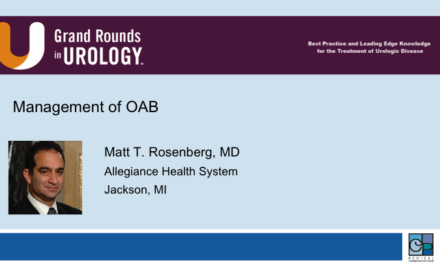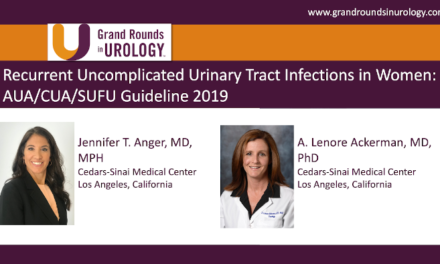Christopher P. Smith, MD, MBA, MSS, presented “Management of Refractory OAB Patients: Insights from a 20-year Experience Using Advanced OAB Techniques” at the 26th Annual Innovations in Urologic Practice on September 15th, 2022.
How to cite: Smith, Christopher P. “Management of Refractory OAB Patients: Insights from a 20-year Experience Using Advanced OAB Techniques” September 2022. Accessed Apr 2024. https://grandroundsinurology.com/management-of-refractory-oab-patient-insights-from-a-20-year-experience-using-advanced-oab-techniques/
Management of Refractory OAB Patients: Insights from a 20-year Experience Using Advanced OAB Techniques – Summary
Christopher P. Smith, MD, MBA, MSS, Associate Professor of Urology at the Baylor College of Medicine, discusses management of patients with overactive bladder (OAB) based on insights from his 20 years of clinical experience. Dr. Smith reviews urinary tract function and highlights the bladder-brain control network. He addresses the urothelial lining of the bladder, the most metabolically active layer in the bladder, and cites a study showing botulinum toxin inhibits adenosine triphosphate (ATP) release from bladder urothelium after chronic spinal cord injury. He explains that the urothelium is ideally suited to delivery of potential therapies for OAB. Dr. Smith then explains that, while OAB and other conditions (e.g., interstitial cystitis [IC], underactive bladder [UAB], urinary tract infection [UTI]) are usually not seen together, they are not mutually exclusive. Multiple studies have implicated UTI in the pathogenesis of OAB. Dr. Smith states the etiology of OAB contains multiple phenotypes, one being the association of metabolic syndrome and OAB, which are two conditions that have overlapping contributors. Dr. Smith predicts that in the future, we may see a paradigm shift in the approach to OAB treatment, depending on the characterization of the underlying badder phenotype, explaining that currently the biomarkers are not sensitive enough to phenotype OAB patients. With that in mind, Dr. Smith advises to “see the forest through the trees” and focus on improving what bothers patients the most, promote global bladder health (e.g., bladder irritants, UTI prevention), and address other factors that may impact symptoms and treatment (e.g., metabolic syndrome). Dr. Smith then emphasizes the importance of patient-centered care and empathy for treatment efficacy, with shared decision-making having the potential to improve therapy adherence and outcomes and reduce healthcare expenditures. Dr. Smith then cites a retrospective clinical study involving 11 centers that treat OAB patients initially with 100 units of onabotulinumtoxin A (BTX-A), focusing on the rate of incomplete emptying or UTIs. Data showed a high rate of incomplete emptying at six months, especially among males, and a UTI rate of approximately 22 percent. He then cites data from a pooled analysis of adverse event rates after botulinum injection in men with refractory OAB that show a nearly 30 percent rate of UTI and an only slightly lower rate of incomplete emptying. Dr. Smith explains that small changes in technique can sometimes lead to better patient outcomes. Dr. Smith concludes that it is important to focus on the bladder and the urothelium, saying “it’s not that deep.” Many OAB patients have multiple conditions that are not always mutually exclusive. Physicians should focus on the patient’s main complaint without ignoring other factors that can impact treatment, using patient-centered care and empathy. Finally, sometimes there is value in stepping back and making changes to technique to gain a better outcome for the patient.
About The 26th Annual Innovations in Urologic Practice:
Presented by co-chairs Mohit Khera, MD, MBA, MPH, and Michael Coburn, MD, FACS, the Innovations in Urologic Practice conference provides a detailed review and commentary on multiple genitourinary and urologic diseases. Among the featured oncological topics are bladder cancer and immunotherapies, as well as upper tract cancer management, prostate cancer, including state-of-the-art imaging, focal therapy, and MRI. Experts also discuss new tools and techniques for nephrectomy and treating advanced renal cell carcinoma. In terms of general urological approaches, the conference also includes pelvic reconstruction and trauma; men’s health topics like male infertility, andrology, and sexual dysfunction; OAB and voiding dysfunctions; and ways to diagnose and treat infections in the urology patient.
For further educational activities from this conference, visit our collection page.




